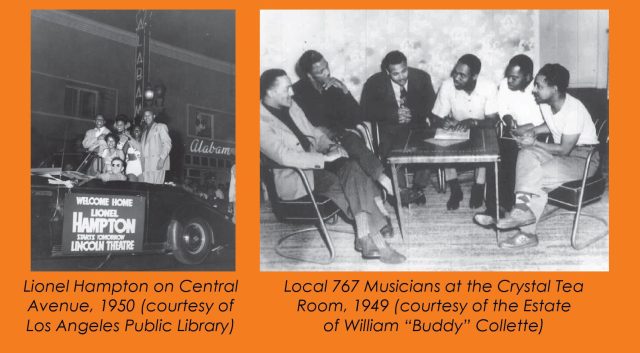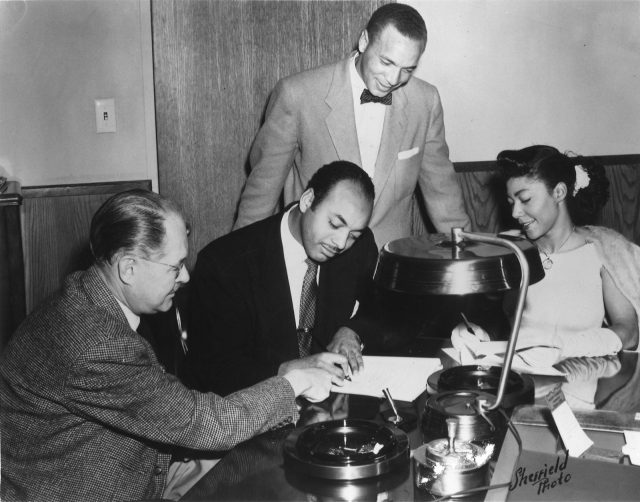Allegro
How the Los Angeles musicians’ unions came together
A series on the racial history of the AFM
Volume 123, No. 10November, 2023
Local 802’s diversity initiative called the DECIBAL Collective has an important mission. (See the Allegro stories “Introducing Local 802’s DECIBAL Collective” and “A Kickoff Event for Diversity at Local 802.”) One of the six working groups that emerged from the formation of the collective is producing a series of Allegro articles on the racial history of the AFM. This will include an examination of the “hyphenated” locals, most of which were the result of the merging of Black and white locals. Welcome to the third article in our series (read our first article here and our second article here).

Local 47 was formed in 1897 in Los Angeles and affiliated with the AFM in the same year. For its first 56 years, it was an organization only for white musicians. As mentioned in a previous article in this series, this was not an explicit ban by the AFM, but rather a practice of excluding Black musicians from white locals. The segregation of musicians along racial lines mirrored the racial divisions typical in the U.S. at the time.
Local 767 was formed in 1920, and was created by and for African-American musicians in order to have a voice in their working conditions, since they were not welcome to join Local 47. Despite the talents and contributions of Black musicians, they faced discrimination and limited opportunities, especially when it came to lucrative jobs in emerging industries like film and radio.
Most of the jobs available to Black musicians were in clubs and theatres along Central Avenue, where pay was around $10 a night. As the recording and film industries developed in L.A. in the inter-war and post-war years, lucrative jobs in radio orchestras ($200 to $300 per week), movie studios ($50 to $100 per day), and eventually television studios blossomed. Local 47 negotiated contracts with the studios because white musicians were overwhelmingly hired for these jobs. The few Black musicians who were able to secure jobs in one of these sectors were paid under the same contracts as white musicians. Local 767 was never involved in the negotiating process; it merely adopted the same guidelines as Local 47. The division meant that African-American musicians were largely left out of negotiations that determined pay rates, working conditions, and other essential matters for those working in the booming entertainment industries.
In 1951, a grassroots movement of Black and white musicians began conversations about integrating the musicians’ unions in LA. There were informal meetings, multi-racial rehearsals of the Community Symphony Orchestra, integrated jam sessions at Local 767, and pamphlets distributed to get people involved in organizing. Celebrities such as Josephine Baker, Nat King Cole, and Benny Carter were brought in to try to bring more visibility and credibility to the movement. These efforts put pressure on both unions to consider integration.
The push for amalgamation of the two unions in the early 1950s was, in part, a reflection of broader civil rights movements occurring across the U.S. The grassroots efforts to integrate the unions represented a struggle not just for equal representation within the music industry, but also for broader racial equality and justice.
Initially, the Local 767 leadership was resistant to the idea of amalgamation. Only after rank-and-file 767 members interrupted a board meeting in 1951 to force the issue was a committee formed to discuss a proposal of amalgamation of the two locals. The movement got involved in union election campaigns and in December 1951 succeeded in electing a pro-amalgamation majority to the Board of Directors at Local 767.
In early 1952, the Local 767 Amalgamation Committee met with the Local 47 Board of Directors. The committee chairperson, Benny Carter, presented the idea of amalgamation to the board. Local 47 President, John teGroen suggested that Local 47 would be amenable to the idea if Local 767 dissolved. Black members could then come and join Local 47 and pay the initiation fee. While the Local 47 board showed they were not resistant to amalgamation, this simple “solution” clearly was not favored by Local 767 members, who had paid dues and fees to Local 767 for seniority and benefits. Hence, a negotiation process began.
The main issues in the negotiations related to lifetime membership, death benefits, and the financial assets of Local 767. In the spring of 1952, members of the Local 767 committee (largely led by Marl Young, a pianist who had a law degree) ironed out many of the details. It was agreed that Local 767 members would retain most of their Local 767 death benefits, lifetime membership would apply from the date a musician joined Local 767, and all the financial assets of Local 767 would be absorbed by Local 47. The proposed details were brought to the Local 47 board in the summer of 1952, but the Local 47 board rejected the proposal and the movement seemed to stall.
By this time, a group of white Local 47 members had organized as Musicians for Amalgamation. This committee held meetings, used the Local 47 mailing list to rally rank-and-file members behind the cause for amalgamation, and made the moral argument that segregation was wrong. Eventually, it was grassroots support from both Black and white musicians that pushed for the Local 767 proposal to be the template for the merger. The Local 47 board was pressured to hold a general vote of its membership to adopt the Local 767 proposal.
In December 1952, the proposal for amalgamation was approved by membership of Local 47. The proposal then needed to be approved by Local 767 members, who also voted on it. In January 1953 the measure was approved by over two-thirds of its membership.
To give this event of desegregation some historical context: 1953 was one year before the Supreme Court decision of Brown v. Board of Education, four years before Rosa Parks refused to give up her seat on a Montgomery bus, and eleven years before the Civil Rights Act of 1964.
On April 1, 1953, Local 47 accepted all Local 767 members into full membership at Local 47. This was the first time Black and white musicians who had belonged to separate locals were represented by one AFM Local. The Local 767 finances and sold property were “amalgamated” into Local 47 and it was decided that there would not be a hyphenated union number.
After amalgamation, Local 47 wasn’t completely devoid of racist practices. In the mid-1950s, it was discovered that a white worker at the hiring desk at Local 47 was underlining information on Black musicians’ contact cards, as a way to discourage hiring Black musicians. This practice was discovered, halted, and the employee was reprimanded. Additionally, it wasn’t until 1957 that a Black member of Local 47 was elected to the Board of Directors — that member was Marl Young.
Unions are always stronger when they act together. The amalgamation of the two unions meant that Black musicians had a more significant voice within the merged union, ensuring that their concerns and needs were better represented during negotiations. It provided a template for every other segregated local in the country. In conclusion, the amalgamation of the musicians’ unions in Los Angeles during 1951 to 1953 was a significant step towards racial equality within the music industry and reflected broader societal shifts towards integration and justice during the civil rights era.
Neil Johnson, a member of Local 802 since 2013, plays saxophone, flute, and clarinet based in New York City. He has performed with a variety of artists at Carnegie Hall, Lincoln Center, Glastonbury Festival and Montreal Jazz Festival. Neil plays Reed1 at “Back to the Future: The Musical” on Broadway and is a committed teacher, mentor, and ally.

Local 47 member Marl Young signing the “amalgamation papers” that would merge Local 47 with Local 767. (Photo courtesy Local 47.)
Sources:
- “Central Avenue Sounds: Jazz in Los Angeles,” Bryant, Collette, et al
- “Jazz Generations : A Life in American Music and Society,” Buddy Collette and Steven Isoardi
- “Benny Carter: A Life in American Music,” Berger, Berger, and Patrick
- Overture (Local 47 magazine), 1988
